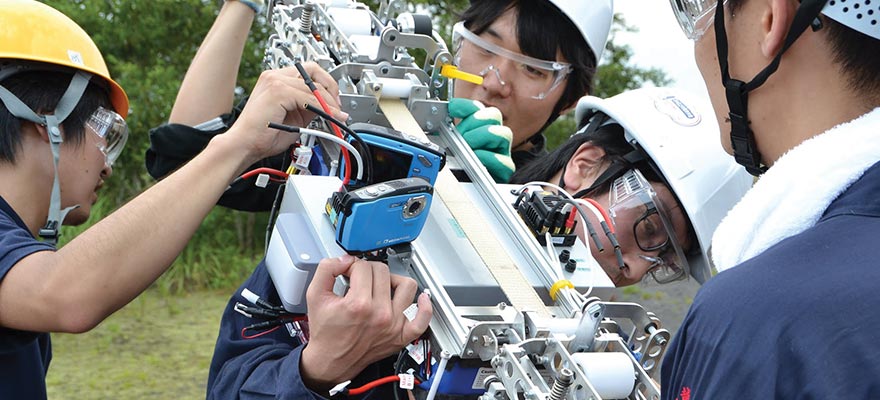Home > Highlighting JAPAN >Highlighting Japan July 2014>Science & Technology
Highlighting JAPAN
Science & Technology
Outer Space Connection
The dream of building a space elevator

Aspace elevator is just what it sounds like—a vehicle that travels up and down a cable connecting the Earth's surface to space. Space elevators are well known in the science fiction world, having appeared, for example, in Arthur C. Clarke's novel The Fountains of Paradise. While building a space elevator is a theoretical possibility, it has long been considered far beyond our capabilities.
The discovery of carbon nanotubes (CNTs) by Dr. Sumio Iijima in 1991, however, had some people beginning to ask whether space elevators might now be feasible on a technical level. With CNTs that are strong and light enough, we could build the Earth-to-space tether viewed as the biggest obstacle to making space elevators a reality. Moves toward implementation have accelerated since then, including the 2007 founding of the Japan Space Elevator Association (JSEA), which promotes technologies for space elevators and conducts activities to educate the public about them.
"Japan specializes in many of the key component technologies of space elevators, from the CNTs that were discovered in Japan to safety and control technologies developed for elevators, bullet trains and the like," says JSEA Chairman Shuichi Ohno, one of the space elevator's proponents. "We would love to move this technology forward with Japan at the center."
The actual mechanism of the space elevator is simple: just connect the Earth to a space station with a cable and a counterweight. The key issue is adjusting the balance between gravity—which pulls things toward the Earth—and centrifugal force, which pushes them away. Gravity grows stronger as objects get closer to the Earth, while centrifugal force increases when they are farther away. These forces balance out in a geostationary orbit at an altitude of around 36,000 km. At this orbiting level, one revolution around the Earth is 24 hours, just like the Earth's rotation. Since stations placed in geostationary orbit move with the Earth's rotation, they remain fixed in relation to the planet and would be able to keep the cable pulled taut.
During construction, the cable would be lowered toward the Earth from a satellite in geostationary orbit. If nothing more is done, however, the weight of the cable itself would pull it Earthward as the center of gravity approaches the planet. The cable would therefore have to be balanced by also extending it away from the Earth and with the counterweight. One approach would be to extend the cable little by little while maintaining that balance until it eventually reaches the base station on Earth, with both stationary land-based platforms and mobile seagoing platforms possible.
A space elevator constructed in this way could transport large numbers of people and stocks of material using far less fuel than a rocket. Moreover, although astronauts require specialized training, space elevators would make it easier for even ordinary people to go to space because the training needed would be much more basic. Since transporting people and goods would be inexpensive, it would also help lower the barriers to space development itself, like space solar-power generation projects that efficiently collect sunlight in outer space and produce energy, as well as zero-gravity experiments and the like. Many commentators even expect the technology to trigger growth in space exploration.
There are innumerable challenges, such as how to protect space elevators from electromagnetic waves, radiation from the sun, meteorites and space debris. But some researchers and engineers are infatuated with the idea due to the sheer potential it has to revolutionize space development and exploration. Various contests both in Japan and abroad—to climb the highest or build the best tether—have generated great interest.
In the new Mobile Suit Gundam: Reconguista in G coming out this fall—the latest in a Japanese robot animation series that takes place in outer space and is popular worldwide—the story will apparently revolve around an organization that operates a space elevator. The real thing will someday be constructed, leading to a world where everyone can easily go to space, propelled by those who dream of such an adventure. Japan hopes to lead that quest.
© 2009 Cabinet Office, Government of Japan






